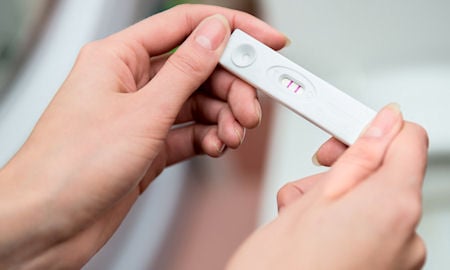
Third Party Reproduction
In recent years, with the standardization of IVF-ET techniques and the development of ICSI (intracytoplasmic sperm injection) for severe sperm disorders, it has become clear that the single most important factor in predicting the success of IVF-ET is the age of the female partner. For patients under 30, success rates of 30-50% per oocyte retrieval can legitimately be expected; for patients over 40, realistic success rates are only 5% to at most 20%. Oocytes from younger women possess greater fertility potential, and this potential is utilized in donor oocyte treatment. In this situation, oocytes from another woman (the donor) are fertilized with the patient’s (the recipient) husband’s sperm, and the resultant embryos are placed in the recipient’s uterus. The oocytes are stimulated and retrieved from the donor using routine IVF-ET techniques. The donor may be known to and recruited by the recipient (non-anonymous donation), or instead may be unknown to the recipient, having been recruited by the IVF-ET program (anonymous donation) or by a donor egg agency. Anonymous oocyte donation usually occurs when a young, fertile woman donates all of her oocytes to a recipient during a particular cycle. This woman is not trying to achieve pregnancy and will therefore be reimbursed for her time and effort. In this case the recipient is responsible for all prerequisite costs for the oocyte donor as well as the cycle. Each recipient couple must decide the type of donor with whom they are most comfortable. In cases where a young (less than 33 years old) donor is utilized, high success rates, comparable to those achieved in women of similar age using their own oocytes, can be expected.
Candidates for Third Party Reproduction
There are four main indications for the need of donor oocyte.: 1) ovarian failure. This can be due to a wide variety of different causes, including radiation, chemotherapy, surgical removal of the ovaries and a variety of disease states which cause or are associated with ovarian failure; 2) women who carry some serious genetic disease who wish to diminish the chance that the disease will be passed on to their offspring; 3) women whose age is sufficiently advanced so that their fertility potential is impaired significantly; abd 4) women who have had poor quality embryos during previous IVF cycles.
Laboratory Testing, Genetic Screening, and Psychological Assessment
A short time before initiating a treatment cycle, the oocyte donor undergoes a very thorough battery of tests for sexually transmitted diseases. Obviously, by screening for sexually transmitted diseases, we seek to minimize the chances that such a disease will be passed from the donor to the recipient (and possible fetus) by the oocyte donation process. Despite these thorough precautions, a very small risk of transmission of disease from donor to recipient remains. In addition to sexually transmitted disease testing, the donor’s blood type will be determined. The donor’s blood type may be a factor in making the match between donor and recipient (see below).
All donors have a very thorough evaluation of their medical, psychological, and family history. The donor is required to fill out a multi-page form detailing her family history. The IVF personnel and a genetic counselor for the oocyte donation program review this form and other aspects of the donor’s genetic and medical history prior to acceptance of the donor into the program. The genetic counselor sometimes recommends additional testing for the donor. Even with this intensive screening, there remains a small risk that a baby resulting from the oocyte donation process will suffer from a genetic disease. Overall, a baby conceived through oocyte donation will have the same risk of birth defect, trivial or catastrophic, genetic or nongenetic, as the human population as a whole, namely 3-5%. The donor should also receive psychological screening and counseling with a mental health professional to assess her motivations and ability to follow through in the process. This evaluation serves as an additional opportunity to learn about family and medical history which may affect her acceptance as a donor.
Matching Donor and Recipient
We understand that choosing to receive donated oocytes carries with it a simultaneous sacrifice of hope for pregnancy with one’s own oocytes, and this can be a feeling of great loss. There are probably many characteristics that you hope your oocyte donor will possess, and you probably desire that your oocyte donor will possess many of your own characteristics. The IVF team does what it can to assist you in selecting a donor who meets your most important expectations, but you must understand that we will always face certain limitations. One requirement of most anonymous donation program is that anonymity be maintained. In order to accomplish this, we are limited in the amount of information that we can give you about the donor. We cannot tell you much more than donor’s height and weight, hair color and eye color, race, blood type, age and duration of formal education. We also give you as much family medical history as we know. You have the right to be as specific as you like about the characteristics of the donor, but you need to understand that the more specific you are, the longer the entire process may be delayed. Obviously, if your criteria are extremely specific and detailed, we may never find a donor who meets your expectations. Studies indicate that women who agree to donate their oocytes tend to be upbeat, energetic, resilient and altruistic. If they did not have these personality characteristics, they probably would not be willing to undergo the discomfort and risks involved in oocyte donation and IVF in the first place. Thus, to at least a small extent, the process of oocyte donation tends to select from women with these favorable personality characteristics. Some donors are women who are attempting conception through IVF themselves.
The blood type of the recipient, donor and recipient’s husband are factors that can play some role in the matching process. Blood typing at its most basic level is defined by two separate typing systems. One is referred to as the ABO system. Four different types exist in this system, A, B, AB, and O. The other basic blood typing system is the Rh type. Only two Rh types are common, positive and negative. Thus, a routine blood type is described as one of the four ABO types and one of the two Rh types. The main element of the blood typing system, which has the potential to affect the health of a pregnant woman’s baby, is the Rh-negative type. Serious compromise of a baby’s health can occur when an Rh-negative woman is carrying an Rh-positive fetus. With modern obstetrical treatment, such complications are uncommon, but they still exist. There are two ways an Rh-negative woman can have an Rh-positive baby. One is if the father of the baby is Rh positive, and the baby inherited Rh positivity from the father. The other way this can happen is if an Rh-negative woman receives an oocyte from a donor who is Rh positive, and the genetic makeup of the oocyte confers Rh positivity on the resulting fetus. Thus, practically speaking, the main situation in which the blood type of the egg donor can pose increased risk for the recipient is when both the recipient and her husband are Rh negative. In this circumstance, the use of an Rh positive donor would expose the recipient’s fetus to a risk of Rh incompatibility that would not have existed had the woman used her own eggs or received eggs from an Rh negative donor.
Differences in ABO type between mother and fetus pose little risk to the health of the fetus. Therefore, use of an oocyte donor whose oocyte might produce a pregnancy, which is different from ABO type of the recipient and husband, is not such a serious medical matter. Although ABO incompatibility is of negligible importance medically, we understand that to some recipient couples it may still be an important factor to match, so that genetically impossible differences in ABO type between parents and child are not revealed later in life.
Treatment of the Oocyte Donor
In general, stimulation of the oocyte donor’s cycle is brought about using a similar regimen of drugs that a woman using her own oocytes for in vitro fertilization-embryo transfer is commonly given. Late in the cycle which precedes ovarian stimulation, the donor is started on daily treatment with one of two drugs, Lupron® or Synarel®, usually the former. Daily injections of Lupron® will continue for a total of nearly three weeks. After the donor’s period has started, daily intramuscular injections of a pharmaceutical gonadotropin preparation, such as FSH and HMG, will be added to the daily Lupron® injections. Various brands of these hormones can be used. Generally, the donor will receive daily gonadotropin injections for a total of seven to twelve days. During the time that the donor is receiving the gonadotropin injections, she will have frequent vaginal ultrasound examinations and blood drawing for determination of estradiol (E2) level. When ultrasound and blood testing indicate that development of the follicles (follicles are the ovarian structures that contain the oocytes) is optimum, the donor receives an intramuscular injection of a different pharmaceutical medication called human chorionic gonadotropin (hCG). Two days (35 hours) after hCG injection, oocyte retrieval is performed. We will need a sperm specimen from the recipient’s partner on the day of the retrieval, because the oocytes are inseminated on this day. Transfer of fertilized eggs (embryos) to the recipient’s uterus is generally performed three days after the oocyte retrieval. Sometimes embryo transfer is delayed until five days after oocyte retrieval, based upon recommendations by the embryologist and physician team.
Treatment Regimen for Recipients
In general, we try to arrange for recipients to have a "fresh" as opposed to frozen embryo transfer. In order to do this, the recipient’s cycle must be manipulated to synchronize her with the donor. A combination of two or three hormonal medications is used to modify the recipient’s cycle.
Recipients who have regular menstrual cycles and bleeding on their own will take a medication which suppresses their own cycle. Sometimes oral contraceptives will be used to precede Lupron® or Synarel® administration. A few days before the recipient’s period is expected to start, she is started on Lupron® to suppress her natural cycle. A short time after her period starts the recipient will begin taking estrogen patches in addition to the Lupron®. The formulation of estrogen that works best for our purposes, is the Vivelle® 0.1 patch or its equivalent. This is applied to the abdomen or buttocks for absorption through the skin. These patches are changed every other day. The recipient will take Lupron® and estrogen patches while waiting for the donor’s cycle to come into synchrony with hers. When the donor’s cycle has “caught up” with the recipient’s, a simulated (artificial) 28 day menstrual cycle will be created in the recipient with the hormonal medications. To do this, the recipient takes an increased dose of patches as the donor stimulates. We perform blood tests for hormone levels and/or an ultrasound as oocyte retrieval approaches to ensure an appropriate response. Lupron® treatment will continue throughout this time. On the morning after oocyte retrieval, progesterone treatment is begun. Progesterone is given usually as a daily intramuscular injection of a preparation of progesterone in oil. The day before embryo transfer, Lupron® is discontinued. The recipient will continue taking Vivelle® and progesterone at least until the day her pregnancy test is performed. Fresh embryo transfer will be performed 3-5 days after oocyte retrieval. A sensitive blood pregnancy test will be performed on the 10th day after embryo transfer. If the recipient is pregnant, patches and progesterone treatment will be continued through the twelfth week of pregnancy.
Recipients who have complete ovarian failure and have no spontaneous menstrual cycles will not have to take Lupron®, but otherwise will take the same regimen of medications just described.
In most instances a "trial cycle" is not performed to evaluate endometrial lining prior to the actual synchronized cycle. It has been our experience that endometrial thickness and hormonal levels during most patients’ artificial hormone cycle are adequate for implantation. In the rare instance that the physicians feel that the endometrial lining is not adequate for embryo transfer, a recommendation for freezing embryos and doing a trial cycle prior to embryo transfer is made. This has proven to be a policy that is both cost effective and time saving for the recipient without compromising success rate.
Gestational Carriers
In some instances a couple may require the assistance of a gestational carrier to achieve a successful pregnancy. Gestational carriers differ from true surrogates in that they have no genetic link to the baby they will carry. The commissioning couple themselves will provide the embryo through IVF. As with oocyte donation, the best statistics occur when the embryos are transferred during a fresh cycle, requiring that the women and her gestational surrogate be synchronized as with oocyte donation. Some states have laws that address surrogacy and you should seek legal advice about this. For example, Florida law requires that a woman have a medical indication for a gestational carrier to be utilized. The most common indications include a woman who has congenital absence of the uterus, prior surgery to remove her uterus, severe scarring of the uterine cavity, or a medical history that precludes pregnancy. In addition to meeting the medical requirement, a separate legal contract is required before treatment can begin. In Texas, in order for the carrier not to be identified as the legal mother, the surrogacy arrangement must be reviewed and approved by a judge before treatment begins. Programs may or may not have ready access to a group of potential gestational carriers. Generally, however, they can provide resources for investigation. Once a gestational carrier has been identified and the medical, psychological, and legal prerequisites completed, treatment can proceed.

